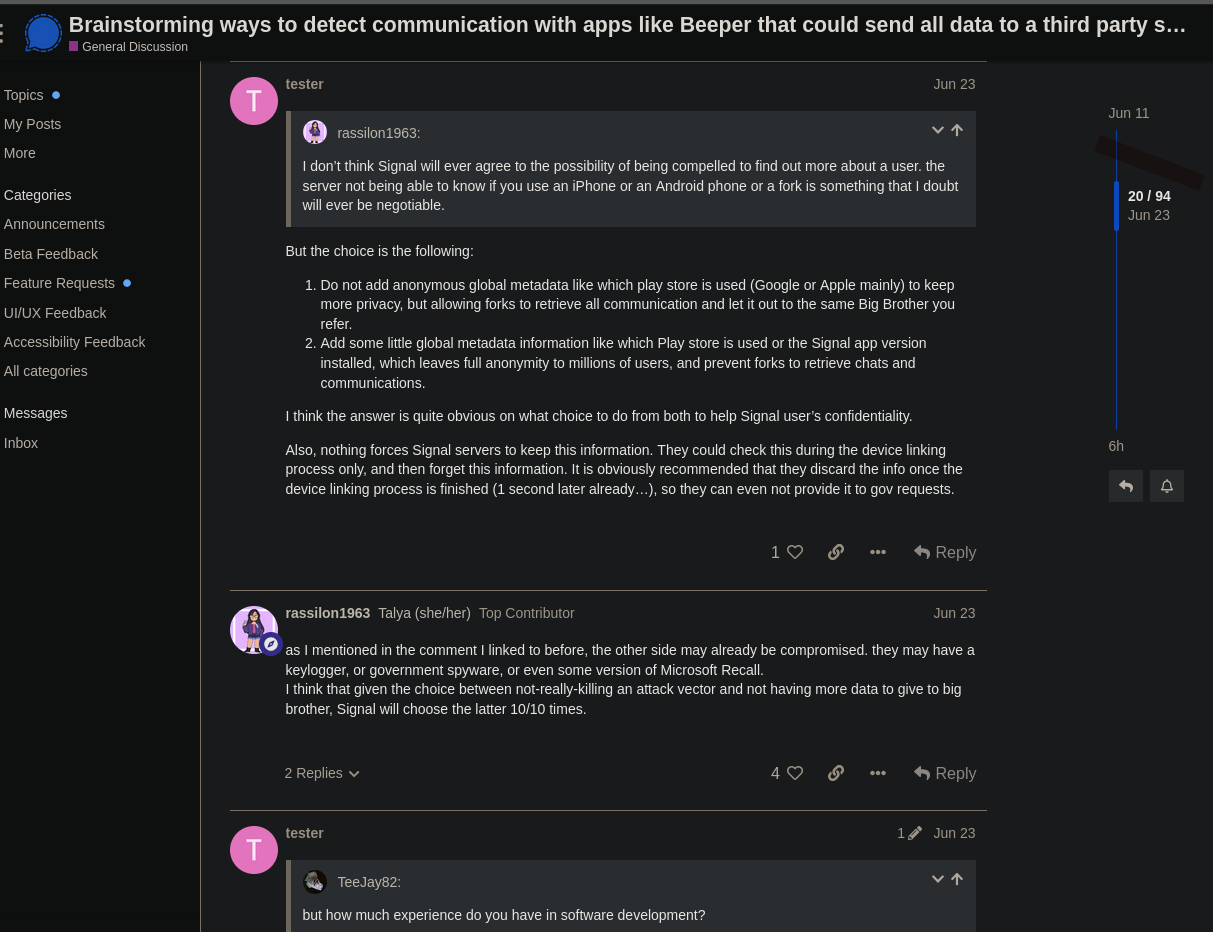For me it’s: Testdisk (ad Photorec) Caddy Netstat Dig Aria2
Usbip, I’m learning how to build a Python GUI by making one for usbip bind and usbip attach.
What do you use USB/IP for?
My laptop, desktop pc, and VMs are running Linux. All of them (except the laptop) are remotely accessible over the local network via Moonlight game stream using Sunshine as the hosting software.
I use USB/IP to send things like a Dualsense controller, or USB headset over the network, as well as my yubikey if I need to log into something with FIDO2 authentication remotely. (I haven’t tested my yubikey over usb/ip yet but I will eventually) I’ve also managed to use my racing wheel this way but if it lags it hurts the game badly.
Webcam / headset / USB storage devices / game controllers work just fine so far.
Ffmpeg.
Came here for this one
Try WinFF
I’ve kinda grown towards CLI the last year or so. I used to make wrappers around CLIs for myself even haha
I’d love supported GUI apps for pacman and systemd. I know there are GUI’s out there for them, but they are not supported by the main project, so they don’t count.
Yeah I think a good GUI for systemd will be super useful even for people comfortable with command line.
Sometimes you need an overview of what is running on the system.
There’s a TUI called sysz for systemd stuff, but I haven’t found a true GUI
TIL! thanks!
Systemd’s problems won’t be solved with a GUI. Now that lennart’s gone to Microsoft we can hope they upgrade in rhel10 or 11 to upstart or sysv.
Why don’t they count? The systemd interface has been stable for a decade.
They don’t count for me, because I can’t get support from the main project if it has a bug.
You can’t get support from lemmy.linuxuserspace.show or any other website if there’s a bug in your web browser. You can’t get support from gmail or protonmail or any other mail provider if there’s a bug in your email client. It’s awful how much people have come to assume that clients and servers must and always come from the same provider.
For me it’s the other way around I wish there would be better CLI support for GUI apps.
Any examples?
pavucontrol. I switch between usb headset and my external speakers all the time. Continually going to this gui is kind of annoying.
I use a little oneliner with tofi (rofi/wofi would also work) to select the current output and avoid pavucontrol. It’s mapped to a sway binding but would probably work in any wm/de:
pactl set-default-sink $(pactl list short sinks |awk '{print $2}' |tofi $tofi_args)I’m using pipewire so the functionality of pactl is actually provided through pipewire-pulse I think
Does set-default-sink change an already current stream? Or do you need move-sink-input.
I’ve looked at the manpages but was a bit overwhelmed and didn’t try to make my own script. Your solution gives me motivation to do so. I also use sway and pipewire. Though I use fuzzel for my launcher.
I love programs like freecad despite the really hard/unintuitive gui. 95% of all the modelling i need to do (as an amateur) can be done easily in a python script.
The finishing touches like adding filets and chamfers are the annoying part were gui is easier, due to the way edges are referenced.
Likewise at work, we have to produce a lot of regular reports in excel. All done via python / sql.
- Gimp to batch edit pictures in a script (I know about ImageMagick but still)
- Excel to change stuff in excel files quickly (I know about python modules but it’s so complicated to use)
- Proprietary VPN software like Cisco AnyConnect, I want to automate the login when I boot, but they don’t let me
Just from the top of my head.
Check out openconnect to connect to anyconnect VPNs
I did, doesn’t work with our company setup with 2FA.
What kind of prompt does your company 2FA provide? Using openconnect with networkmangler, I get a pop up to input my pin+totp. I haven’t done the script way in the last few years, but the connection script is plain shell and I was able to handle the 2FA from there too
For anyconnect: openconnect works perfectly, either as standalone script or via networkmangler.
For Excel there is a PowerShell module called Import-Excel that I use all the time.
I see, nice, but I’m on Linux, so perhaps I need to run power shell there ^^
I forgot where I was posting. (I use both win and Linux pretty heavily.) I have pwsh, let me see if import-excel works on linux and report back.
Appears to work as well as it does on windows. I guess the only downside is learning powershell if you have no previous experience with it.
If you don’t want to use PowerShell in Linux, there’s also nushell, which is another (non-POSIX) shell that can process Excel files
- Gimp to batch edit pictures in a script (I know about ImageMagick but still)
It seems to exist: https://www.gimp.org/tutorials/Basic_Batch/
There are many things you can do in the GIMP gui that can’t be done programmatically :(
This is one reason I love FreeCAD. Everything done in the GUI is just a python call
This, but for a Fireshot like tool. Screenshot and pdf of webpages in their entirety by scrolling while shotting. In bulk, with CLI.
Do you have a legitimate use-case for this?
It’s also the use cases supported by Linkwarden:
Does this support sites that lazy load content as you scroll?
Not sure, search on “screenshot lazy load Fireshot” or “screenshot lazy load Linkwarden” does not turn up anything conclusive.
Do you have an example?
https://discourse.gnome.org/t/towards-a-better-way-to-hack-and-test-your-system-components/21075
This one doesn’t actually seem to load new network requests, but the way the scrolling works seems to break any other screenshot application I’ve tried.
Can confirm, tested it with Signal forum, also discourse. Fireshot stops at the end of the current loaded messages (20 of 94) and doesnt scroll further by itself.

Dont know if it’s illegitimate otherwise 😉
But my user story is like this:
I want to preserve and archive information I used because it’s a reflection of the things I did, learned and studied throughout life.
Then my use case are:
- Orientation about “events”: places to visit on daytrips or holidays (musea, nature, parks, campsites) and looking for practical information and background as well.
- Gather a “dossier”: info to help make a decision (buying expensive things, how to do home improvement etc)
- Building a personal knowledge database: interesting articles and blogs.
My current workflow:
- Browse
- Bookmark extensively
- Download pdf or other content (maps, routes, images) when provided.
- Open bookmarks.
- Fireshot every webpage to pdf and png
- Save everything with a consequent filename (YYYYMMDD - Source - Title)
I would like to automate the last 3 steps of my workflow.
It’s been years since I had to admin Windows servers, but I was quite impressed with the number of MS products where the install and configuration tools would output the Powershell commands to carry out the changes you’d asked for. It made it quite a lot easier to automate. I’d love to see that paradigm catch on more widely, with the GUI and CLI having the same functionality and the GUI giving you the commands to run.
I like gui file browser with integrated console window that prints all the commands you trigger by using gui as well.
yt-dlp. Too many options to remember and look up every time, but all useful and missing from GUIs when you just want to dowload audio or ‘good enough’ quality video in batches without re-encoding.
While nmtui is perfectly fine for the CLI-uninitiated, I sometimes wonder why the nm-connection-editor window doesn’t provide the same level of functionality.
I believe ytDownloader might be what you’re looking for. It’s a yt-dlp frontend, you can export to video/audio pretty easily. And it’s in active development. I’ve used it to export short clips to WAV a few times, nothing too fancy, but so far it works pretty well.
There’s a firefox extension that generates the cli command for whatever video you’re on. Let’s you check boxes for the format, sponsorblock, etc and then copies it to your clipboard.
Just search the addon store for yt-dlp and it should show up
You can have most of the settings pre-loaded in its config file. I mostly let it do my preset -f, or when that fails do a -F to see what encodings are available.
Btw, here’s my config file.
-o "%(title)s (%(uploader_id)s).%(ext)s" -P ~/Videos -P "temp:/tmp/yt-dlp/" -f 271+ba[language=en][ext=m4a]/308+ba[language=en][ext=m4a]/137+ba[language=en][ext=m4a]/299+ba[language=en][ext=m4a]/231+ba[language=en][ext=m4a]/http_mp3_128/271+140/308+140/137+140/299+140/231+140 --download-archive ~/.config/yt-dlp/dl-archive --no-playlist --write-sub --no-mtime --compat-options no-live-chat
Too many options to remember and look up every time
This is a good use case for shell aliases. If you can identify a few of your use cases, you can give each bundle of options its own command.
I do exactly this for downloading music, I aliased my preferred options to ‘yt-audio’
Would you mind sharing your command?
This is what I use (with zsh):
yt-audio() { yt-dlp --no-playlist -f 'ba' -x --audio-format mp3 $1 } yt-audio-playlist() { yt-dlp -f 'ba' -x --audio-format mp3 $1 }It takes the best quality available and downloads it to mp3.
(Windows only warning, unless someone wants to add Linux support)
I didn’t really search around for GUIs way back, but ended up making a basic GUI because I wanted to learn programming.
With just having options as checkboxes for YouTube-dl. It has served me well all these years. It was literally the thing I made while learning programming so the code is pretty janky when I look back at it though…
Bad link
It’s a link to an image on github not sure why it doesn’t work for you. Try just looking at the repo then:
Restic Backup!
I’d love to have archivemount or a similar tool integrated in a file manager
I’d also love to have some sort of full featured gui software to install and manage custom roms in phones, allowing to do everything, from unlocking bootloaders to downloading and flashing/upgrading roms. For the tasks that require manual steps, it could offer illustrated steps, with a community driven database of phone models.
I’m surprised at the shortage of good Borg repository visualization tools. There are tools but they’re either incomplete or they try to do too much.
Pandoc, for sure. I love its versatility, it’s made it super easy for me to do most of my writing in markdown — and a lot of MD editors have it built-in as an export feature.
But I use it too rarely to know the CLI commands by heart, and sometimes it would just be super helpful to open a GUI and batch convert (and/or collate) a bunch of files to a new format.
Tell you what, throw Imagemagick and maybe a light OCR backend into the package as a Swiss Army Knife for document management, I’d probably be happy.
swap and zram configuration. lots of games need more than distro defaults
Git - the Github Desktop application is a great example of how easy git could be for users like me who only rarely use git. Every time I need to do somethign other then a simple pull or push I need to look it up and by the time I need it again I have forgotten the command and need to look it up again. Just give me something like Github Desktop on linux
Lazygit, beautiful, terminal based, runs everywhere
Lazygit
Thats pretty good, thanks.
Just of the top of my head discovered today.
Not a GUI as one exists. But a more configurable one as it is crap for visually impaired.
Rpi-imager gui dose not take theme indications for font size etc. Worse it has no configuration to change such thing.
Making it pretty much unsuable for anyone with poor vision.
Also it varies for each visually impaired indevidual. But dark mode is essential for some of ua.
So if your looking for small projects. Youd at least make me happy;)
Wireguard
There are a bunch of GUI wg apps.
Rclone. Not because it’s a complicated tool, but because I would like a history of my file transfers and a few graphs to show we what speeds, files sizes and whether the transfer succeeded. At the moment in order to confirm my home backups have succeeded, I have to run a separate size comparisons between my different datastores.
Probably not what you want, but rclone now has a simple web ui built in: https://rclone.org/gui/
I looked at it a few months back and it didn’t have the history side of things, just the setup and realtime stats which I’d already got through the CLI. Thanks tho!
I feel like you can parse a --dry-run
Thanks. I think I looked at doing that when setting it up, and it was more expensive in terms of API calls. With a cloud vendor you have to be careful of that, so I opted for the SIZE command.











